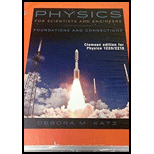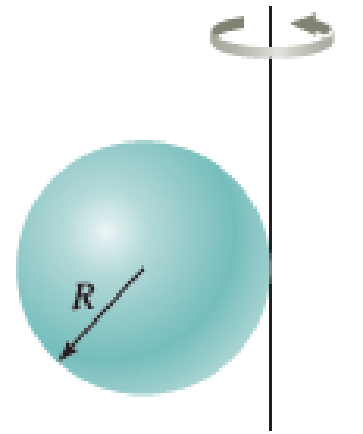
Physics for Scientists and Engineers: Foundations and Connections
15th Edition
ISBN: 9781305289963
Author: Debora M. Katz
Publisher: Cengage Custom Learning
expand_more
expand_more
format_list_bulleted
Textbook Question
Chapter 13, Problem 9PQ
A solid sphere of mass M and radius R is rotating around an axis that is tangent to the sphere (Fig. P13.9). What is the rotational inertia of the sphere in this scenario in terms of M and R?

FIGURE P13.9
Expert Solution & Answer
Trending nowThis is a popular solution!

Students have asked these similar questions
Physics #9
Math 57
Point charges q1 = 50 µC and q2 = −25 µC are placed 1.0 m apart. What is the magnitude of the force on a third charge q3 = 40 µC placed midway between q1 and q2? (The prefix µ =10−6 C.)
Chapter 13 Solutions
Physics for Scientists and Engineers: Foundations and Connections
Ch. 13.1 - CASE STUDY When Is Energy Conserved? Under what...Ch. 13.6 - Figure 13.24 shows a particle with momentum p....Ch. 13.7 - Prob. 13.3CECh. 13.7 - Prob. 13.4CECh. 13.7 - Prob. 13.5CECh. 13 - Prob. 1PQCh. 13 - Prob. 2PQCh. 13 - A Frisbee flies across a field. Determine if the...Ch. 13 - Prob. 4PQCh. 13 - Prob. 5PQ
Ch. 13 - Rotational Inertia Problems 5 and 6 are paired. 5....Ch. 13 - A 12.0-kg solid sphere of radius 1.50 m is being...Ch. 13 - A figure skater clasps her hands above her head as...Ch. 13 - A solid sphere of mass M and radius Ris rotating...Ch. 13 - Suppose a disk having massMtot and radius R is...Ch. 13 - Problems 11 and 12 are paired. A thin disk of...Ch. 13 - Given the disk and density in Problem 11, derive...Ch. 13 - A large stone disk is viewed from above and is...Ch. 13 - Prob. 14PQCh. 13 - A uniform disk of mass M = 3.00 kg and radius r =...Ch. 13 - Prob. 16PQCh. 13 - Prob. 17PQCh. 13 - The system shown in Figure P13.18 consisting of...Ch. 13 - A 10.0-kg disk of radius 2.0 m rotates from rest...Ch. 13 - Prob. 20PQCh. 13 - Prob. 21PQCh. 13 - In Problem 21, what fraction of the kinetic energy...Ch. 13 - Prob. 23PQCh. 13 - Prob. 24PQCh. 13 - Prob. 25PQCh. 13 - A student amuses herself byspinning her pen around...Ch. 13 - The motion of spinning a hula hoop around one's...Ch. 13 - Prob. 28PQCh. 13 - Prob. 29PQCh. 13 - Prob. 30PQCh. 13 - Sophia is playing with a set of wooden toys,...Ch. 13 - Prob. 32PQCh. 13 - A spring with spring constant 25 N/m is compressed...Ch. 13 - Prob. 34PQCh. 13 - Prob. 35PQCh. 13 - Prob. 36PQCh. 13 - Prob. 37PQCh. 13 - Prob. 38PQCh. 13 - A parent exerts a torque on a merry-go-round at a...Ch. 13 - Prob. 40PQCh. 13 - Today, waterwheels are not often used to grind...Ch. 13 - Prob. 42PQCh. 13 - A buzzard (m = 9.29 kg) is flying in circular...Ch. 13 - An object of mass M isthrown with a velocity v0 at...Ch. 13 - A thin rod of length 2.65 m and mass 13.7 kg is...Ch. 13 - A thin rod of length 2.65 m and mass 13.7 kg is...Ch. 13 - Prob. 47PQCh. 13 - Two particles of mass m1 = 2.00 kgand m2 = 5.00 kg...Ch. 13 - A turntable (disk) of radius r = 26.0 cm and...Ch. 13 - CHECK and THINK Our results give us a way to think...Ch. 13 - Prob. 51PQCh. 13 - Prob. 52PQCh. 13 - Two children (m = 30.0 kg each) stand opposite...Ch. 13 - A disk of mass m1 is rotating freely with constant...Ch. 13 - Prob. 55PQCh. 13 - Prob. 56PQCh. 13 - The angular momentum of a sphere is given by...Ch. 13 - Prob. 58PQCh. 13 - Prob. 59PQCh. 13 - Prob. 60PQCh. 13 - Prob. 61PQCh. 13 - Prob. 62PQCh. 13 - A uniform cylinder of radius r = 10.0 cm and mass...Ch. 13 - Prob. 64PQCh. 13 - A thin, spherical shell of mass m and radius R...Ch. 13 - To give a pet hamster exercise, some people put...Ch. 13 - Prob. 67PQCh. 13 - Prob. 68PQCh. 13 - The velocity of a particle of mass m = 2.00 kg is...Ch. 13 - A ball of mass M = 5.00 kg and radius r = 5.00 cm...Ch. 13 - A long, thin rod of mass m = 5.00 kg and length =...Ch. 13 - A solid sphere and a hollow cylinder of the same...Ch. 13 - A uniform disk of mass m = 10.0 kg and radius r =...Ch. 13 - When a person jumps off a diving platform, she...Ch. 13 - One end of a massless rigid rod of length is...Ch. 13 - A uniform solid sphere of mass m and radius r is...Ch. 13 - Prob. 77PQCh. 13 - A cam of mass M is in the shape of a circular disk...Ch. 13 - Prob. 79PQCh. 13 - Consider the downhill race in Example 13.9 (page...Ch. 13 - Prob. 81PQ
Knowledge Booster
Learn more about
Need a deep-dive on the concept behind this application? Look no further. Learn more about this topic, physics and related others by exploring similar questions and additional content below.Similar questions
- The de-excitation of a state occurs by competing emission and relaxation processes. If the relaxation mechanisms are very effective:a) the emission of radiation is largeb) the emission of radiation is smallc) the emission occurs at a shorter wavelengthd) the de-excitation occurs only by emission processesarrow_forwardm C A block of mass m slides down a ramp of height hand collides with an identical block that is initially at rest. The two blocks stick together and travel around a loop of radius R without losing contact with the track. Point A is at the top of the loop, point B is at the end of a horizon- tal diameter, and point C is at the bottom of the loop, as shown in the figure above. Assume that friction between the track and blocks is negligible. (a) The dots below represent the two connected blocks at points A, B, and C. Draw free-body dia- grams showing and labeling the forces (not com ponents) exerted on the blocks at each position. Draw the relative lengths of all vectors to reflect the relative magnitude of the forces. Point A Point B Point C (b) For each of the following, derive an expression in terms of m, h, R, and fundamental constants. i. The speed of moving block at the bottom of the ramp, just before it contacts the stationary block ii. The speed of the two blocks immediately…arrow_forwardThe velocity of an elevator is given by the graph shown. Assume the positive direction is upward. Velocity (m/s) 3.0 2.5 2.0 1.5 1.0 0.5 0 0 5.0 10 15 20 25 Time (s) (a) Briefly describe the motion of the elevator. Justify your description with reference to the graph. (b) Assume the elevator starts from an initial position of y = 0 at t=0. Deriving any numerical values you need from the graph: i. Write an equation for the position as a function of time for the elevator from t=0 to t = 3.0 seconds. ii. Write an equation for the position as a function of time for the elevator from t = 3.0 seconds to t = 19 seconds. (c) A student of weight mg gets on the elevator and rides the elevator during the time interval shown in the graph. Consider the force of con- tact, F, between the floor and the student. How Justify your answer with reference to the graph does F compare to mg at the following times? and your equations above. i. = 1.0 s ii. = 10.0 sarrow_forward
- Students are asked to use circular motion to measure the coefficient of static friction between two materials. They have a round turntable with a surface made from one of the materials, for which they can vary the speed of rotation. They also have a small block of mass m made from the sec- ond material. A rough sketch of the apparatus is shown in the figure below. Additionally they have equipment normally found in a physics classroom. Axis m (a) Briefly describe a procedure that would allow you to use this apparatus to calculate the coefficient of static friction, u. (b) Based on your procedure, determine how to analyze the data collected to calculate the coefficient of friction. (c) One group of students collects the following data. r (m) fm (rev/s) 0.050 1.30 0.10 0.88 0.15 0.74 0.20 0.61 0.25 0.58 i. Use the empty spaces in the table as needed to calculate quantities that would allow you to use the slope of a line graph to calculate the coefficient of friction, providing labels with…arrow_forwardPART Aarrow_forwardanswer both questionarrow_forward
- Only part A.) of the questionarrow_forwardIn general it is best to conceptualize vectors as arrows in space, and then to make calculations with them using their components. (You must first specify a coordinate system in order to find the components of each arrow.) This problem gives you some practice with the components. Let vectors A = (1,0, -3), B = (-2, 5, 1), and C = (3,1,1). Calculate the following, and express your answers as ordered triplets of values separated by commas.arrow_forwardIn general it is best to conceptualize vectors as arrows in space, and then to make calculations with them using their components. (You must first specify a coordinate system in order to find the components of each arrow.) This problem gives you some practice with the components. Let vectors A = (1,0, −3), B = (-2, 5, 1), and C = (3,1,1). Calculate the following, and express your answers as ordered triplets of values separated by commas.arrow_forward
arrow_back_ios
SEE MORE QUESTIONS
arrow_forward_ios
Recommended textbooks for you
 College PhysicsPhysicsISBN:9781305952300Author:Raymond A. Serway, Chris VuillePublisher:Cengage Learning
College PhysicsPhysicsISBN:9781305952300Author:Raymond A. Serway, Chris VuillePublisher:Cengage Learning Physics for Scientists and Engineers: Foundations...PhysicsISBN:9781133939146Author:Katz, Debora M.Publisher:Cengage Learning
Physics for Scientists and Engineers: Foundations...PhysicsISBN:9781133939146Author:Katz, Debora M.Publisher:Cengage Learning Glencoe Physics: Principles and Problems, Student...PhysicsISBN:9780078807213Author:Paul W. ZitzewitzPublisher:Glencoe/McGraw-Hill
Glencoe Physics: Principles and Problems, Student...PhysicsISBN:9780078807213Author:Paul W. ZitzewitzPublisher:Glencoe/McGraw-Hill Principles of Physics: A Calculus-Based TextPhysicsISBN:9781133104261Author:Raymond A. Serway, John W. JewettPublisher:Cengage Learning
Principles of Physics: A Calculus-Based TextPhysicsISBN:9781133104261Author:Raymond A. Serway, John W. JewettPublisher:Cengage Learning Physics for Scientists and Engineers with Modern ...PhysicsISBN:9781337553292Author:Raymond A. Serway, John W. JewettPublisher:Cengage Learning
Physics for Scientists and Engineers with Modern ...PhysicsISBN:9781337553292Author:Raymond A. Serway, John W. JewettPublisher:Cengage Learning Physics for Scientists and EngineersPhysicsISBN:9781337553278Author:Raymond A. Serway, John W. JewettPublisher:Cengage Learning
Physics for Scientists and EngineersPhysicsISBN:9781337553278Author:Raymond A. Serway, John W. JewettPublisher:Cengage Learning

College Physics
Physics
ISBN:9781305952300
Author:Raymond A. Serway, Chris Vuille
Publisher:Cengage Learning

Physics for Scientists and Engineers: Foundations...
Physics
ISBN:9781133939146
Author:Katz, Debora M.
Publisher:Cengage Learning

Glencoe Physics: Principles and Problems, Student...
Physics
ISBN:9780078807213
Author:Paul W. Zitzewitz
Publisher:Glencoe/McGraw-Hill

Principles of Physics: A Calculus-Based Text
Physics
ISBN:9781133104261
Author:Raymond A. Serway, John W. Jewett
Publisher:Cengage Learning

Physics for Scientists and Engineers with Modern ...
Physics
ISBN:9781337553292
Author:Raymond A. Serway, John W. Jewett
Publisher:Cengage Learning

Physics for Scientists and Engineers
Physics
ISBN:9781337553278
Author:Raymond A. Serway, John W. Jewett
Publisher:Cengage Learning
Rotational Kinetic Energy; Author: AK LECTURES;https://www.youtube.com/watch?v=s5P3DGdyimI;License: Standard YouTube License, CC-BY